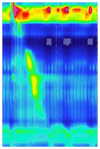Influence of endoscopic submucosal dissection on esophageal motility
- PMID: 23922477
- PMCID: PMC3732852
- DOI: 10.3748/wjg.v19.i29.4781
Influence of endoscopic submucosal dissection on esophageal motility
Abstract
Aim: To assess esophageal motility after esophageal endoscopic submucosal dissection (ESD).
Methods: Twelve patients (6 men and 6 women) aged 53-64 years (mean age, 58 years) who underwent regular examination 3-12 mo after esophageal ESD for neoplasms of the esophageal body were included in this study. The ESD procedure was performed under deep sedation using a combination of propofol and fentanyl, and involved a submucosal injection to lift the lesion and use of a dual-knife and an insulated-tip knife to create a circumferential incision around the lesion extending into the submucosa. Esophageal motility was examined using a high-resolution manometry system. Dysphagia was graded using a five-point scale according to the Mellow and Pinkas scoring system. Patient symptoms and the results of esophageal manometry were then analyzed.
Results: Of the 12 patients enrolled, 1 patient had grade 2 dysphagia, 1 patient had grade 1 dysphagia, and 3 patients complained of sporadic dysphagia. Ineffective esophageal motility was observed in 5 of 6 patients with above semi-circumference of resection extension. Of these 5 patients, 1 patient complained of grade 2 dysphagia (with esophageal stricture), one patient complained of grade 1 dysphagia, and 3 patients complained of sporadic dysphagia. Normal esophageal body manometry was observed in all 6 patients with below semi-circumference of resection extension. The 6 patients with normal esophageal motility did not complain of dysphagia.
Conclusion: Extensive esophageal ESD may cause esophageal dysmotility in some patients, and might also have an influence on dysphagia although without esophageal stricture.
Keywords: Dysphagia; Endoscopic submucosal dissection; Esophageal manometry; Esophageal neoplasm; Ineffective esophageal motility.
Figures
Similar articles
-
Useful strategies to prevent severe stricture after endoscopic submucosal dissection for superficial esophageal neoplasm.World J Gastroenterol. 2015 Jun 21;21(23):7120-33. doi: 10.3748/wjg.v21.i23.7120. World J Gastroenterol. 2015. PMID: 26109798 Free PMC article. Review.
-
Changes in esophageal motility after endoscopic submucosal dissection for superficial esophageal cancer: a high-resolution manometry study.Dis Esophagus. 2017 Nov 1;30(11):1-8. doi: 10.1093/dote/dox057. Dis Esophagus. 2017. PMID: 28881900
-
Esophageal Motility after Extensive Circumferential Endoscopic Submucosal Dissection for Superficial Esophageal Cancer.Digestion. 2018;98(3):153-160. doi: 10.1159/000487751. Epub 2018 Jun 5. Digestion. 2018. PMID: 29870972
-
Evaluation of esophageal motility after endoscopic submucosal dissection for superficial esophageal cancer.Eur J Gastroenterol Hepatol. 2015 Oct;27(10):1187-92. doi: 10.1097/MEG.0000000000000431. Eur J Gastroenterol Hepatol. 2015. PMID: 26225867
-
Prevention of esophageal strictures after endoscopic submucosal dissection.World J Gastroenterol. 2014 Nov 7;20(41):15098-109. doi: 10.3748/wjg.v20.i41.15098. World J Gastroenterol. 2014. PMID: 25386058 Free PMC article. Review.
Cited by
-
Ineffective Esophageal Motility (IEM): the Old-New Frontier in Esophagology.Curr Gastroenterol Rep. 2016 Jan;18(1):1. doi: 10.1007/s11894-015-0472-y. Curr Gastroenterol Rep. 2016. PMID: 26685862 Review.
-
Gastrointestinal Motility Issues in Cancer Patients.Curr Gastroenterol Rep. 2019 Dec 10;21(12):69. doi: 10.1007/s11894-019-0738-x. Curr Gastroenterol Rep. 2019. PMID: 31823129 Review.
-
Effect of Esophageal Endoscopic Submucosal Dissection on Motility and Symptoms: A Prospective Study.Gastroenterol Res Pract. 2018 Jun 3;2018:3735473. doi: 10.1155/2018/3735473. eCollection 2018. Gastroenterol Res Pract. 2018. PMID: 29967638 Free PMC article.
-
Proton pump inhibitor after endoscopic resection for esophageal squamous cell cancer: multicenter prospective randomized controlled trial.J Gastroenterol. 2016 Feb;51(2):104-11. doi: 10.1007/s00535-015-1085-9. Epub 2015 May 5. J Gastroenterol. 2016. PMID: 25940151 Clinical Trial.
-
Useful strategies to prevent severe stricture after endoscopic submucosal dissection for superficial esophageal neoplasm.World J Gastroenterol. 2015 Jun 21;21(23):7120-33. doi: 10.3748/wjg.v21.i23.7120. World J Gastroenterol. 2015. PMID: 26109798 Free PMC article. Review.
References
-
- Oyama T, Tomori A, Hotta K, Morita S, Kominato K, Tanaka M, Miyata Y. Endoscopic submucosal dissection of early esophageal cancer. Clin Gastroenterol Hepatol. 2005;3:S67–S70. - PubMed
-
- Fujishiro M, Yahagi N, Kakushima N, Kodashima S, Muraki Y, Ono S, Yamamichi N, Tateishi A, Shimizu Y, Oka M, et al. Endoscopic submucosal dissection of esophageal squamous cell neoplasms. Clin Gastroenterol Hepatol. 2006;4:688–694. - PubMed
-
- Kato H, Tachimori Y, Watanabe H, Yamaguchi H, Ishikawa T, Itabashi M. Superficial esophageal carcinoma. Surgical treatment and the results. Cancer. 1990;66:2319–2323. - PubMed
-
- Roth JA, Putnam JB Jr. Surgery for cancer of the esophagus. Semin Oncol. 1994;21:453–461. - PubMed
MeSH terms
LinkOut - more resources
Full Text Sources
Other Literature Sources
Medical
Miscellaneous


